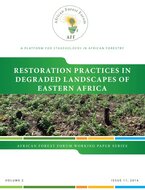The highest deforestation and forest degradation rates in Africa occur in the dry forests and woodlands where the pressure for land is continuously increasing, poverty is rampant, livelihood options are few, and climate change effects are severe and expected to become even more severe. In addition, land and forest tenure and rights of access to forest and woodland resources are either not clearly defined or non-existent to many people. Restoration of degraded forest and tree resources as well as woodland areas, therefore, may contribute to both peoples livelihoods and environmental quality. An assessment was conducted in some countries in Eastern Africa (EA) in order to document local experiences in restoring degraded forest and tree resources as well as woodland areas. The specificobjectives of the study were to:
assess ways and experiences farmers and other stakeholders have and are using to rehabilitate degraded lands, and forest and tree resources in woodlands and savannahs in EA;
identify and describe the technologies and practices that have been very successful in rehabilitating degraded lands, and forest and tree resources in EA and the conditions for their success;
evaluate the extent to which such successful technologies and practices and their prerequisite conditions can be up-scaled in woodlands and savannahs of EA.
Both published and grey literature was accessed from different sources to obtain data and/or information on land degradation and technologies used for rehabilitation/restoration in countries of EA. Literature review was supplemented by field visits in the western
Tanzania region of Shinyanga where native forests have been subjected to intense human pressure in recent decades, resulting in severe deforestation and degradation. The western Tanzania area is characterized by a heavy grazing by the large number of animals and the use of forests as a source of energy. In addition, information on forest management from other regions of Tanzania was collected, especially, on Participatory Forest Management (PFM). The study showed that natural regeneration through active involvement of local communities promoted under PFM and/or collaborative forest management, and supported by the new forestry legislation, is by far the most successful and promising option for restoration of the large areas of degraded lands in Eastern Africa. This is because local communities are allocated clear forest land rights, and their traditional knowledge and management practices (e.g. Ngitili) are taken into account.

